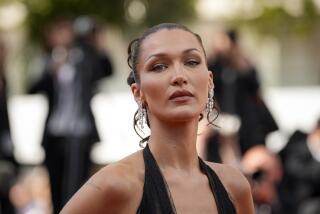Benetton Softens Ads on Racial Harmony : Marketing: The apparel maker’s campaign still pictures black and white people together--but in less provocative situations.
- Share via
Benetton has gone sweet--if not saccharin--in its advertising.
Less than a year after its racially themed print ad campaign caused a national stir, the hip Italian clothing and accessories maker is about to introduce a far less provocative print campaign.
Gone are the ads that feature a black man and white man handcuffed to each other. Gone, too, is the ad that appeared in European publications featuring a black woman nursing a white baby.
Replacing them are ads that feature white and black children eating candy bars together and another with a white dog and black cat snuggled ear to ear. The ads still carry the slogan “United Colors of Benetton.”
“We’re not apologizing, we’re just reaffirming our essence in softer tones,” said Patrizia Spinelli, fashion director at the New York office of Benetton. “This doesn’t mean that next time around, we won’t be provocative again.”
Although many apparel executives say they are impressed with past Benetton campaigns, some say this latest move may be a sign of Benetton compromising under the strain of fast growth. “That happens when you get large,” said Michael Tomson, president of Gotcha Sportswear. “The bigger companies get, the more intimidated you become by risk-taking.”
Since it entered the United States in 1983, Benetton not only has grown fast, it has also won the fashion-forward hearts of female consumers in their early teens. The company--which sells clothing, fragrances, shoes, watches and even sunglasses--has 650 stores in the United States and posted worldwide sales last year of about $1.2 billion.
But the general public may be even more familiar with its advertising than its clothing.
Benetton ads are all created by Eldorado, a Paris-based ad firm, and placed in magazines and on billboards in the United States by the J. Walter Thompson agency. The print ads primarily appear in magazines popular with young girls, such as Seventeen.
The new ads still feature blacks and whites together but now in less piquant situations. In one, a white girl eats a chocolate candy bar while a black youth next to her munches on white chocolate. Another ad features two black and white bakers--covered in white flour--together holding a loaf of dark bread.
The more subdued tone to these ads is intentional. Several ethnic groups objected to the ad with the shackles last year. As a result, Benetton has rethought its ad strategy. “Our ads are provocative, but there’s also a message,” said Spinelli. “That message is to promote racial harmony.”
In 1983, when its ad campaign first began to appear in the United States, it quickly caught consumer attention. The print ads have consistently ranked among the best remembered in the business.
“The ads have great impact,” said Philip Sawyer, editor of “Tested Copy,” a monthly newsletter on print advertising effectiveness published by Starch INRA Hooper, a Mamaroneck, N.Y.-based research firm. One recent Benetton ad in Seventeen magazine, for example, ranked 96% higher in memorability than most other clothing ads in the publication, he said.
“People remember them,” Sawyer said, “but it might be that sometimes people remember them for negative reasons.”
Some say that instead of just modifying the current campaign, Benetton may be wiser to dump its racial harmony theme altogether. “They were way ahead of their time when they first introduced it, but the novelty is wearing off,” said Lisa Lytle, fashion editor of California Apparel News, a Los Angeles trade publication. “It doesn’t have the impact it once did.”






